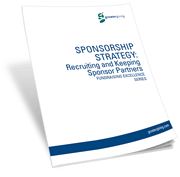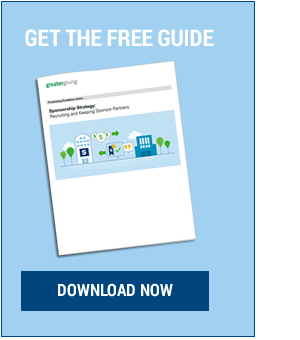

This post is the first in a series designed to open you up to a new way of viewing sponsors and their role within your nonprofit’s overall strategy. These posts are based on the “Sponsorship Strategy: Recruiting and Keeping Sponsor Partners” eBook from the Greater Giving Fundraising Excellence Series. Each new post focuses on a different part of your sponsor strategy and how best to leverage your value for the greatest mutual benefit. View all released series articles—Sponsorship Strategies
Does this sound familiar at all:
You’re four or five months out from your annual auction. Your team set a goal for sponsorships after last year’s event, and now you’re approaching new sponsors hoping you can recruit just enough of them to scrape past your goal.
But it’s hard to make time for all the research, the phone calls, the personal attention that it takes to secure a commitment from a sponsor while you’re also soliciting top-notch items for your silent auction, sending out event invitations, and organizing catering. The clock is ticking, and sponsors are already sensing it. They know you’re there to ask for money. You feel like Oliver Twist.
If this sounds like you, you’re not the only one. Many nonprofits approach sponsor recruitment on an event-by-event basis—with some repeat sponsors, but usually, you have to go out and grab new ones each year to fill out the budget. And what you end up with is a feverish rush to find funding, settling for sponsors who might not be quite the right fit for your nonprofit, settling for sponsor packages that aren’t quite at the dollar commitment levels you’d hoped for.
The worst part? Sponsors can offer so much value beyond dollars alone—their business acumen, their feedback, promotions that might happen at other times of year. And we’re missing out on all of that if we only tap them when event season rolls around.
Shifting the Paradigm
Fixing your rushed, last-minute dash for sponsors—while simultaneously reaching above and beyond your goal for sponsorship dollars—is going to require you and your team to take a few steps back. It will require rethinking the way your organization as a whole approaches sponsorships and sponsor relationships, and their role in your nonprofit’s year-round operation.
And I want to stress the “greater income” element of this paradigm shift. The benefit of rebuilding your sponsor strategy could be huge in the long term, both in terms of actual sponsor dollars, and in saved opportunity costs.
Imagine if most of your event sponsors were already waiting in the wings when the auction prep began, because they had all signed multi-year sponsorship agreements with you? What if you could count on those dollars already, and the time you normally spent on recruitment could be spent instead on soliciting better items, giving better customer service to your guests, and preparing for your big night?
Step 1: Group Planning Meeting
Pull everyone in for this one, because it’s going to matter.
 Bring in your Board, your staff, anyone who might have connections to potential sponsors, to your big group planning meeting. Your new approach to sponsorships will affect everyone, so lure them to the table (with the promise of more sponsor dollars, and desserts if you have to) to discuss the new way your nonprofit is going to approach sponsorships. You also want them all there to help brainstorm some potential candidates for your new sponsor direction—together.
Bring in your Board, your staff, anyone who might have connections to potential sponsors, to your big group planning meeting. Your new approach to sponsorships will affect everyone, so lure them to the table (with the promise of more sponsor dollars, and desserts if you have to) to discuss the new way your nonprofit is going to approach sponsorships. You also want them all there to help brainstorm some potential candidates for your new sponsor direction—together.Step 2: Broadening the Scope
As a team, set a new, wider scope for your sponsor program. Instead of thinking about sponsors for a specific event, this new scope means your time and labor is more evenly distributed throughout the year; it means your relationships are long-term; it means your commitments, though they’ll take more time to secure, will be bigger and do more for both your nonprofit and for your sponsor.
But broader scope also requires broader planning. This plan expands responsibility on both your nonprofit and your sponsor—but the payoff could be huge.
Step 3: Building Together
If the promise of “more” isn’t enough to sell your new sponsor strategy to your team, then try this: it’s not about what we can get. It’s about what we can build together.
This new strategy, certainly, is about more than just dollars. It’s about tapping every possible resource that a sponsor has to offer, and giving back in kind. And over time, you’re getting to know your sponsor partner better with a long-term relationship than you would on the basis of just a single event. You have the opportunity to find out what else can they offer besides dollars that has big value for your specific nonprofit.
For example, you could look to your sponsors for their business acumen, or for their expertise in an industry, or for their connections and prestige within the community. Or you could ask their top-level staff to join the Board, so you can learn from them. You could offer to do the same for them.
Or perhaps your sponsor could donate a big service or product in-kind, instead of dollars. You could build a sponsor package that suits everyone a bit better, and is more narrowly tailored to both your needs, because you’ve taken the time to find out what those needs are and built a culture of trust and cooperation between you.
This new strategy means a constant give-and-take—the way a long term friendship is a give-and-take.
Step 4: Diversity
While you’re re-evaluating what “value” a sponsor has to offer, you can also expand your scope about who your potential sponsors might be. Having more choices on your target list to ask can really make that solicitation and recruitment process easier—you can be pickier about what you want.
With this new strategy, you’re not just looking for a sponsor who happens to be available at the time of your single auction event… you’re looking at many events over the course of the year. You’re offering multiple opportunities for sponsors to get involved that they can pick and choose from. The menu of ways in which sponsors can choose to engage with you is broader and suits more tastes.
Now, during your ask, you can lay out promotions and benefits that more closely serve a business’s specific needs—making it easier to lock down that coveted commitment!
For an in-depth look into the strategy and a detailed action plan, download the Sponsorship Strategies eBook.

